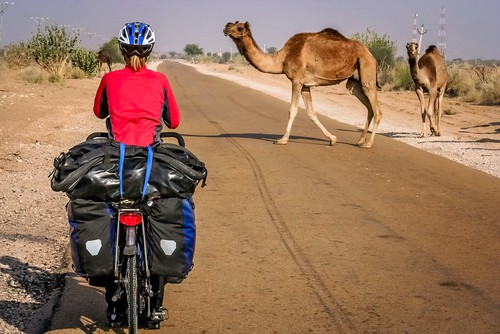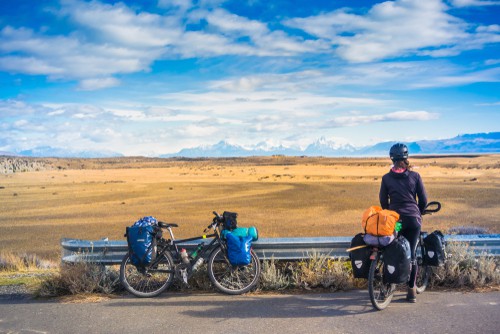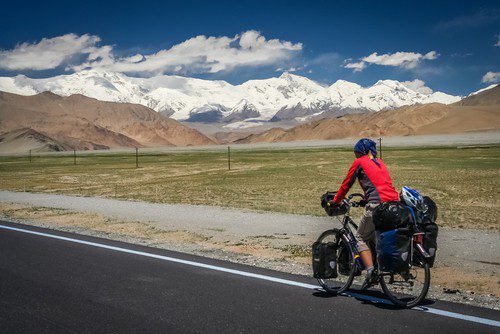A touring bike is an effective way to take extended solo holidays while keeping your journey flexible and exciting throughout. Aside from granting you access to various picturesque locations, touring bikes allow you to carry your favorite gear along with you!
However, strapping baggage onto a touring bike can get tricky, and you need to keep in mind the overall weight you will be lugging around the entire time.
A fully decked-out touring bike weighs (on average) between 55.11 lbs (25 kg) and 110.23 lbs (50 kg). This weight includes the front and rear rack, mudguards, and the luggage you’re carrying.
In this article, we’ll explore why it’s essential to consider the weight of your touring bike before setting off on a trip. We’ll also look at a few FAQs related to touring bikes.
Why Consider Touring Bike Weight?
Most touring bikes come with an assortment of storage spaces, with some giving you enough room to carry your favorite household items (even unnecessary ones). But while a touring bike can take a lot, it’s imperative to pack only the essentials.
Getting a touring bike in the right weight category is essential because you’ll be adding your luggage and your weight to the cycle before setting off on a journey. An unnecessarily heavy bike will make the trip cumbersome and exhausting.
Touring bikes are used primarily for two different purposes – bike touring and bike packing. While both activities are pretty similar and require touring bikes, the way you prepare for each journey tends to differ.
Bike touring refers to long, drawn-out journeys where the biker is away from home for extended periods.
On the other hand, bike packing often refers to smaller journeys over shorter distances. These journeys involve carrying less load than regular tours and have been growing in popularity.
Bike Touring
Bike touring is often used as an umbrella term, encompassing any activity where a rider sets off on a bike loaded with the essentials of a long journey.

Bikes used exclusively for touring tend to be much heavier as they are mounted with a rack and pannier and are often packed with enough luggage for a few weeks.
The rack and pannier setup on a touring bike allows bikers to carry bulky gear and a large portion of the belongings on extended trips. Touring also requires preparation of a different sort compared to bike packing.
A fully-loaded touring bike weighs on average between 25 kg (55.11 lb) and 50 kg (110.23 lbs) and includes all the essential supplies required by the cyclist. The bike’s weight will vary based on how it’s been set up and the amount of luggage strapped to it.
Bike Packing
Bikepacking is a more specialized form of touring that focuses on specific types of terrain (usually unpaved surfaces).
Bikepacking has been steadily gaining popularity over the last few years as it involves less packing, reducing the weight of the bike, and making the trip more enjoyable.
Another reason for the reduced weight is that bike packing is done on unsteady surfaces, and a higher weight reduces stability and maneuverability.
Bikes used for bike packing are usually optimized or modified to handle the specific off-terrain surface you will encounter. On average, a fully-loaded bike weighs roughly 37.47 to 77.16 lbs (17 kg to 35 kg) (usually on the lower end).
By minimizing the weight you need to carry, you increase the rate of acceleration and reduce the effort spent on getting from place to place.
While this is the ideal weight range for most bikers, the correct weight will differ based on certain factors.
Factors That Determine the Weight of a Touring Bike
You probably think that if there’s an ideal weight, and if a lower weight equals less effort, why would anyone pack extra, right? Sometimes it’s not that straightforward, though.
Here are two factors to consider when determining the ideal weight for your touring bike.
Duration of Your Journey
How you prepare for a bike tour will depend entirely on how long you’re planning to travel in the first place. Most people use tour bikes to get away for the weekend, some do a week-long hiatus, and some do it as a lifestyle.
If you’re traveling on your bike for a week, you won’t need more than the essentials. Taking a break from your household luxuries can actually be a welcome change, in this case, giving you the time and space you need to clear your mind.

You can afford to pack light, leave out groceries, and pick up what you need along the way. This way, you reduce the luggage you’re carrying, making it easier to cycle and get to your destination quickly.
But if you’re planning on biking for a month or more, you’ll need to prepare accordingly, and your touring bike is sure to get a lot heavier.
With the bike as your constant companion throughout this journey, it’s best to carry various items to make your trip as comfortable as possible.
These items may include taking bedroom essentials, like a sleeping bag or a pillow, as you’ll need to be well-rested to get up and start cycling again the next day. Remember, packing for a longer and more complicated journey will mean a heavier touring bike.
Your Road Map
The route you’re planning to take is another significant determinant of your touring bike weight.
First, if you’re traveling over rocky or muddy terrain, you may need to strap a cycle pump onto your bike. This type of terrain can cause air to leak out of the tires quickly, and they’ll need to be replenished regularly.
Most importantly, though, you need to pack based on the surroundings you’ll be cycling through during your journey. If you’re biking through a populated part of the world or an urban area, you may need to pack less and can make use of the gift civilization has to offer.
For example, let’s say you’re cycling through European roads. In this case, you may not need to carry a tent or sleeping bag and can instead spend the night at an inexpensive hostel.
Biking through an urban area also means easy access to bathroom facilities for washing or freshening up. Of course, you’ll need to carry your toiletries either way, but you can shed some of the extra weight.
And finally, you won’t need to carry your entire journey’s food along with you as you can stop and eat at food joints or restaurants along the way. The extra food usually makes up for a large portion of a touring bike’s weight, and if you’re traveling through a city, you can lighten the load.
The real challenge in touring is when you need to go offroading or travel through the wilderness and spaces without human inhabitants. And some tourers genuinely enjoy the silence that comes with biking through a forest or mountain trail for days on end.
While this kind of journey seems magical, it often translates to a much heavier tour bike as the traveler needs to stock up on supplies before heading out.
Let’s say you’re traveling for a week through the Australian Outback. This type of journey will require that you carry a week’s worth of food and water on your bike as there’s zero access to either in such a remote part of the world.
To survive the journey, you also need to consider basic comforts, like shelter, a bed, a stove, cooking utensils, and other accessories. As such, touring through remote areas often means more luggage which translates to a much heavier tour bike.
Tips To Consider When Preparing Your Tour Bike
Packing for a bike tour differs significantly from packing for a regular journey. While it’s still safe to overpack on a typical trip, packing too much on a bike tour can ruin the experience.
And it’s not like you can dump your things on the side of the road and carry on! So here are a few things to keep in mind when packing for a bike tour.
Distribute Your Weight Evenly
To make your journey effortless and less physically taxing, focus on distributing your luggage evenly across the front, middle, and rear portions of your bike.
Too much weight on one part of the bike can lead to unnecessary muscle fatigue or strains and can even damage the bike in the long run. Proper luggage distribution will also make it much easier to pedal by ensuring greater control and stability while riding.
Use a Rack and Pannier
Most touring bikes already have these accouterments, but if yours doesn’t, be sure to get a rack and pannier (or another type of bag) before setting off on a journey. By strapping a storage case onto your bike’s front and back ends, you increase storage space.
A container will also ensure that all your belongings are secure and prevent them from making noise as you cycle.
Pack Only the Essentials
While traveling, most of us are tempted to pack too much because, well, everything seems necessary! And while some things are essential, most of what we wish to take isn’t required for the trip.
A good rule of thumb is to make a list of twenty-five items and pack only the first fifteen. Hopefully, the top items will include the essentials, like food, water, and shelter.
Of course, what’s essential will differ based on the kind of journey you’re doing and the duration of your trip. So figure that out, assess your needs, and pack accordingly.
Roll Your Clothes
Rolling your clothes is the most underrated packing tip out there. Rolling can significantly free up space to add more of what you need to take on your trip. Remember that rolling won’t reduce the weight of your touring bike, so only pack what you need.
Leave Some Room
Finally, while packing for a bike tour, it’s crucial to leave some space in your luggage container on either end of your bike. You may need to restock supplies or buy essentials you may have forgotten to take, and here’s where the extra space can come in handy.
What to Pack for a Bike Tour?
Considering that most bike tours occur over long distances, it’s imperative to figure out what exactly you’ll need to pack. Aside from the ‘what,’ you also want to determine where to put each item, so the journey is easier. Here are a few tips to help you out.
Shelter
It’s important to consider what kind of shelter or protection you’ll need to take with you during a bike tour. These items will include your tent, a sleeping bag, and protective rain gear to shield you from adverse weather conditions.
These items should be kept close by for easy access if you need to set up camp or pull the raincoat over your head.
The ideal place to keep these items would be the seat pack near the bike’s center. You want to ensure the seat pack isn’t too heavily weighed down, or it could be difficult to pedal.
Luckily, tents and raingear are lightweight, collapsible items, and the seat pack is ideal for storing them.
Food and Water
Food and water are perhaps the most important items to carry with you during your journey, and cooking up a warm meal at the end of a long cycling journey is the perfect way to unwind.
It’s best to carry food that can be stored indefinitely and that you can cook quickly. These foods include items like pasta or noodles and canned goods you can easily add to the cooking mix.
It would help if you also carried a stove, pot, and cooking utensils along with you, and here’s where all the weight comes in. You want to get yourself a stove and cooking pot that’s not too large and doesn’t get in the way of you pedaling.
Spare Parts and Tools
Now that you’ve packed the two primary items, you must add a few spare parts and tools to your packing list. These items may come in handy in certain situations.
If you’re unsure what to take, here’s a list to help you out:
- Allen wrench
- Flashlight
- Extra Tube
- First-Aid Kit
- Water Purification System
Your needs may differ based on the kind of journey you’re planning, so figure out and ensure you include the essentials in your packing list.
It’s best to get a multi-tool that can take care of various problems that crop up. Having a versatile tool will help reduce the overall weight of your bike.
FAQs
- Is a light touring bike better? A lighter touring bike will make pedaling much more manageable and reduce the amount of effort needed during your journey. However, the weight of your bike depends on the kind of journey you’re undertaking, and a longer, more complicated journey will require a heavier bike.
- Is there a specific weight your touring bike needs to be? No, there is no specified weight for a touring bike. The weight of your bike will differ based on the type of journey you’re making.
- Is a touring bike hard to ride? Yes, riding a touring bike can be extremely challenging compared to riding a regular bike. The difficulty level will vary based on the duration of your trip and the weight of your tour bike.
Related articles:
How Much Water Should You Carry When Cycling?
12 Best Foods To Eat When Cycling Long Distance
Are Gravel Bikes Good for Touring?
8 Expert Tips for Touring on A Road Bike
Sources
- Bicycles Stack Exchange: How Much Should a Long Distance Touring Bike Weigh?
- The Outdoor Revolution: Bike Packing vs. Bike Touring
- World Biking: What is the difference between bikepacking and bicycle touring?
- YouTube: One Year Cycling the World | a Bicycle Touring Short Film
- Wikipedia: Pannier
- Biking Universe: 19 Essential Tips to Prepare for a Bikepacking Trip
- Cycle Travel Overload: Touring Bike and Gear Weight

